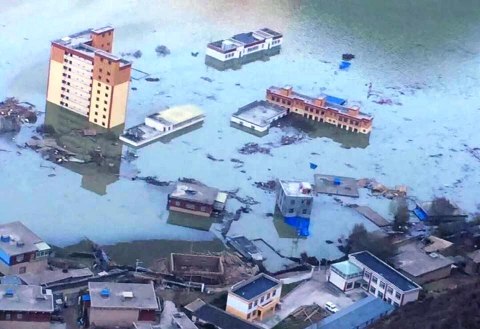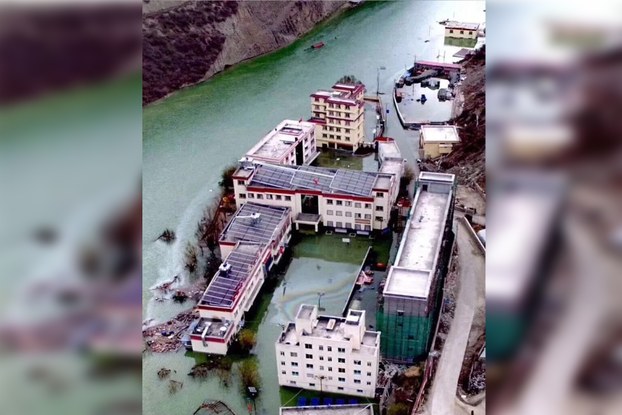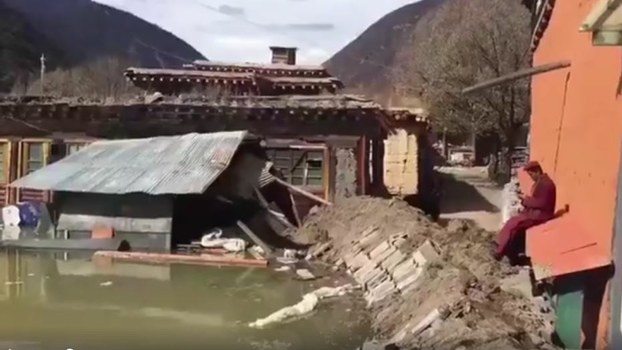THOUSANDS EVACUATED AS SECOND LANDSLIDE HITS CHAMDO AREA
 The unceasing flooding sweeps away whole villages and townships, destroying crucial infrastructure networks
The unceasing flooding sweeps away whole villages and townships, destroying crucial infrastructure networks
One month ago, we reported on the massive landslide and flooding of villages around Chamdo city, Tibetan Autonomous Region. The landslide caused serious blockage of the Drichu River and the following flooding resulted in over 400 people being evacuated from the nearby Polo Township.
On Novemeber 3, another massive landslide hit the same area (the intersection of Phayul, Bhatang and Derong counties), causing further flooding.
The flooding is now reaching hazardous levels with water continuously rising since the incident.
According to the Global Times (media outlet funded by the Chinese government) over 25,000 people had to be evacuated into temporary settlements, 100 houses have collapsed completely and over 843 have been seriously damaged. Phayul.com wrote that “the calamity has affected over 30,000 residents in 15 counties in TAR and Sichuan province”.
The unceasing flooding has swept away whole villages and townships and destroyed crucial infrastructure networks including roads, bridges and schools. Townships of Drichu ka (Payul County), Ganzi (Tibetan Autonomous Prefecture), Polo (Jomda County) and Chamdo city (TAR) have been particularly affected.
The 900 year old Polo Monastery, which is “the most important and old Buddhist temple in the region” (according to Tibetan writer Tsering Woeser on social media), has been completely submerged by water. Its sacred religious artefacts have been ruined beyond repair, with monks and local Tibetans evacuated into the mountains.
The latest videos we have obtained from our research partner Tibet Watch highlight the severity of the situation, showing the high tidal wave streaming down the gorge with an additional landslide occurring at the scene.
Liang Jun, the chief engineer of the Sichuan Provincial Water Resources Department, has warned that the second incident’s danger alert is much higher than the landslide which occurred on 3 October. The continuous flooding could soon reach the hydro-power stations downstream, causing a serious disaster risk to the nearby towns.
The Chinese authorities have been heavily restricting people from obtaining photos or videos of the affected areas. Despite their attempts to hide the truth, the footage circulating on social media reveals the damage as being much worse than what the official narrative suggests.
This is the second time in less than a month, that Tibetan families and households in the area have been severely affected and put at risk by flooding. Despite China’s efforts to frame these events as simply natural disasters, it is now clear that the excessive mining, development and hydro-dam projects are the prime factors behind this environmental destruction.
The Drichu River in particular has been an essential component in a series of Chinese large-scale hydro-dam development projects at the Tibetan Plateau’s southeast corner. There have been 25 dams and 20 hydro-power stations built on the stretch of Drichu River alone.
In recent years, China’s exploitation of Tibet’s natural resources has gathered pace significantly. While China is using Tibet’s environment and resources to sustain its rising industrial demands, Tibetans are unable to protect their land and are the first ones to suffer the consequences of the environmental degradation.
source:https://www.freetibet.org





comment 0